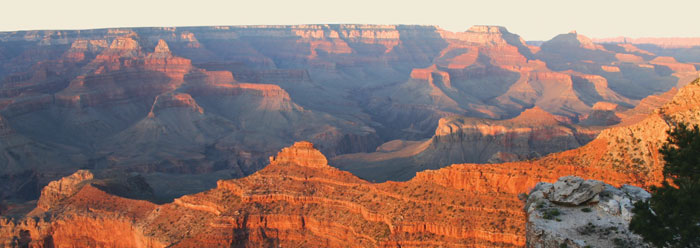The summer of 2007 has gone by FAST—in terms of research, that is. ICR’s Flood Activated Sedimentation and Tectonics geology research program saw exciting progress in four of its seven projects.
Coconino Sandstone Project. Paul Garner and Ray Strom joined principal investigator John Whitmore to explore the Coconino Sandstone, a 300 to 400-foot thick layer of white sandstone near the top of the Grand Canyon. The conventional explanation for this geologic feature is that it was laid down by wind currents, similar to sand dunes in deserts today. Dr. Whitmore and his colleagues are currently examining evidence—such as cross-bedding and other features in the rock layer—that lend credence to the young-earth theory that it was actually laid down by water near the end of the Genesis Flood.
On a side note, Dr. Whitmore, who earned his M.S. in Geology from the ICR Graduate School, was recently honored with the Faculty Teaching Effectiveness Award by Cedarville University, where he is Associate Professor of Geology. Congratulations, Dr. Whitmore.
Tuff Beds in the Tonto Group Project. The tuff beds in the Grand Canyon are proving to be fruitful ground for Bill Hoesch, a research geologist with ICR and another alumnus of the ICR Graduate School. In the spring and summer of 2007, Mr. Hoesch collected evidence from both inside and outside Grand Canyon Park in an effort to ascertain whether the beds were formed by ash from volcanic eruptions that settled through the turbulent waters of the Flood, thereby leaving a recognizable time marker. If an early Flood type-section can be established for the Grand Canyon, it will seriously challenge evolution’s geologic timescale.
Overthrust Reinterpretation Project. After 100 years of study, the origin and emplacement mechanism of the Heart Mountain Detachment Fault and the nearby South Fork Fault in northwest Wyoming remain a mystery—one that lead investigator Tim Clarey and John Baumgardner have joined forces to solve. The most puzzling question is how 50 large carbonate blocks were moved a distance of more than 30 miles downhill along a slope of less than two degrees. The Genesis Flood and the following tectonic activity may well provide the explanation. To that end, this summer Tim purchased a structural analysis computing program for processing the field data. We look forward to their deductions.
Flood Narrative in Genesis Project. Steven Boyd, David Fouts, and project head John Baldwin have begun a comprehensive study of the relevance of Genesis 5:28-9:29 to the geological history of the earth. Their premise is that an understanding of the geology of the Flood must be derived from the Flood narrative in the biblical Hebrew text, since the text imposes constraints on the geological investigation. Some of the issues under consideration are the chronology of the Flood, its totality, its destructive capacity, and its effectiveness in carrying out God’s purposes.
The work of The Genesis Flood continues. With all the advancements in science and research, this is an exciting time to be a biblical creationist.
*Dr. Vardiman is Professor of Atmospheric Science and Director of Research.
Cite this article: Vardiman, L. 2007. A FAST Summer in the Grand Canyon & Wyoming. Acts & Facts. 36 (8): 6.













